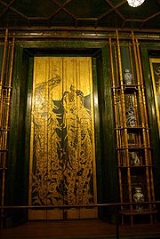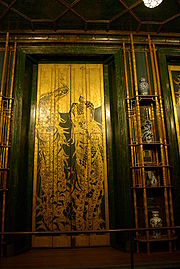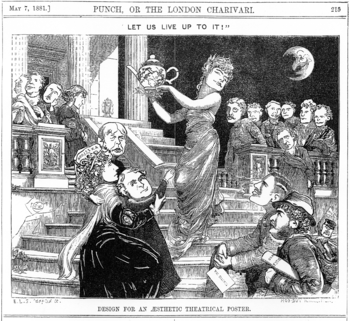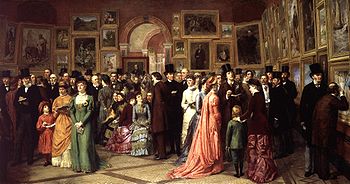
Aestheticism
Encyclopedia

Art movement
An art movement is a tendency or style in art with a specific common philosophy or goal, followed by a group of artists during a restricted period of time, or, at least, with the heyday of the movement defined within a number of years...
that emphasized aesthetic values more than socio-political themes for literature
Literature
Literature is the art of written works, and is not bound to published sources...
, fine art
Fine art
Fine art or the fine arts encompass art forms developed primarily for aesthetics and/or concept rather than practical application. Art is often a synonym for fine art, as employed in the term "art gallery"....
, the decorative arts, and interior design
Interior design
Interior design describes a group of various yet related projects that involve turning an interior space into an effective setting for the range of human activities are to take place there. An interior designer is someone who conducts such projects...
. Generally, it represents the same tendencies that symbolism
Symbolism (arts)
Symbolism was a late nineteenth-century art movement of French, Russian and Belgian origin in poetry and other arts. In literature, the style had its beginnings with the publication Les Fleurs du mal by Charles Baudelaire...
or decadence
Decadent movement
The Decadent movement was a late 19th century artistic and literary movement of Western Europe. It flourished in France, but also had devotees in England and throughout Europe, as well as in the United States.-Overview:...
represented in France, or decadentism
Decadentism
Decadentism was an Italian artistic style based mainly on the Decadent movement in the arts in France and England around the end of the 19th century. The main authors associated with decadentism were Antonio Fogazzaro, Italo Svevo, Giovanni Pascoli and Gabriele D'Annunzio...
o represented in Italy, and may be considered the British version of the same style. It was part of the anti-19th century reaction and had post-Romantic origins, and as such anticipates modernism
Modernism
Modernism, in its broadest definition, is modern thought, character, or practice. More specifically, the term describes the modernist movement, its set of cultural tendencies and array of associated cultural movements, originally arising from wide-scale and far-reaching changes to Western society...
. It was a feature of the late 19th century from about 1868 to about 1900.
Aesthetic literature
The British decadent writers were much influenced by the OxfordOxford
The city of Oxford is the county town of Oxfordshire, England. The city, made prominent by its medieval university, has a population of just under 165,000, with 153,900 living within the district boundary. It lies about 50 miles north-west of London. The rivers Cherwell and Thames run through...
professor Walter Pater
Walter Pater
Walter Horatio Pater was an English essayist, critic of art and literature, and writer of fiction.-Early life:...
and his essays published during 1867–68, in which he stated that life had to be lived intensely, with an ideal of beauty. His text Studies in the History of the Renaissance (1873) was very well regarded by art-oriented young men of the late 19th century. Writers of the Decadent movement
Decadent movement
The Decadent movement was a late 19th century artistic and literary movement of Western Europe. It flourished in France, but also had devotees in England and throughout Europe, as well as in the United States.-Overview:...
writers used the slogan "Art for Art's Sake
Art for art's sake
"Art for art's sake" is the usual English rendering of a French slogan, from the early 19th century, l'art pour l'art, and expresses a philosophy that the intrinsic value of art, and the only "true" art, is divorced from any didactic, moral or utilitarian function...
" (L'art pour l'art), the origin of which is debated. Some claim that it was invented by the philosopher Victor Cousin
Victor Cousin
Victor Cousin was a French philosopher. He was a proponent of Scottish Common Sense Realism and had an important influence on French educational policy.-Early life:...
, although Angela Leighton in the publication On Form: Poetry, Aestheticism and the Legacy of a Word (2007) notes that the phrase was used by Benjamin Constant as early as 1804. It is generally accepted to have been promoted by Théophile Gautier
Théophile Gautier
Pierre Jules Théophile Gautier was a French poet, dramatist, novelist, journalist, art critic and literary critic....
in France, who interpreted the phrase to suggest that there was not any real association between art and morality
Morality
Morality is the differentiation among intentions, decisions, and actions between those that are good and bad . A moral code is a system of morality and a moral is any one practice or teaching within a moral code...
.

John Ruskin
John Ruskin was the leading English art critic of the Victorian era, also an art patron, draughtsman, watercolourist, a prominent social thinker and philanthropist. He wrote on subjects ranging from geology to architecture, myth to ornithology, literature to education, and botany to political...
and Matthew Arnold
Matthew Arnold
Matthew Arnold was a British poet and cultural critic who worked as an inspector of schools. He was the son of Thomas Arnold, the famed headmaster of Rugby School, and brother to both Tom Arnold, literary professor, and William Delafield Arnold, novelist and colonial administrator...
's utilitarian conception of art as something moral or useful. Instead, they believed that Art did not have any didactic purpose; it need only be beautiful. The Aesthetes developed a cult of beauty, which they considered the basic factor of art. Life should copy Art, they asserted. They considered nature as crude and lacking in design when compared to art. The main characteristics of the style were: suggestion rather than statement, sensuality, great use of symbols, and synaesthetic
Synesthesia
Synesthesia , from the ancient Greek , "together," and , "sensation," is a neurologically based condition in which stimulation of one sensory or cognitive pathway leads to automatic, involuntary experiences in a second sensory or cognitive pathway...
effects—that is, correspondence between words, colours and music. Music was used to establish mood.
Predecessors of the Aesthetics included John Keats
John Keats
John Keats was an English Romantic poet. Along with Lord Byron and Percy Bysshe Shelley, he was one of the key figures in the second generation of the Romantic movement, despite the fact that his work had been in publication for only four years before his death.Although his poems were not...
and Percy Bysshe Shelley
Percy Bysshe Shelley
Percy Bysshe Shelley was one of the major English Romantic poets and is critically regarded as among the finest lyric poets in the English language. Shelley was famous for his association with John Keats and Lord Byron...
, and some of the Pre-Raphaelites. In Britain the best representatives were Oscar Wilde
Oscar Wilde
Oscar Fingal O'Flahertie Wills Wilde was an Irish writer and poet. After writing in different forms throughout the 1880s, he became one of London's most popular playwrights in the early 1890s...
and Algernon Charles Swinburne
Algernon Charles Swinburne
Algernon Charles Swinburne was an English poet, playwright, novelist, and critic. He invented the roundel form, wrote several novels, and contributed to the famous Eleventh Edition of the Encyclopaedia Britannica...
, both influenced by the French Symbolists, and James McNeill Whistler
James McNeill Whistler
James Abbott McNeill Whistler was an American-born, British-based artist. Averse to sentimentality and moral allusion in painting, he was a leading proponent of the credo "art for art's sake". His famous signature for his paintings was in the shape of a stylized butterfly possessing a long stinger...
and Dante Gabriel Rossetti
Dante Gabriel Rossetti
Dante Gabriel Rossetti was an English poet, illustrator, painter and translator. He founded the Pre-Raphaelite Brotherhood in 1848 with William Holman Hunt and John Everett Millais, and was later to be the main inspiration for a second generation of artists and writers influenced by the movement,...
. The style and these poets were satirised by Gilbert and Sullivan
Gilbert and Sullivan
Gilbert and Sullivan refers to the Victorian-era theatrical partnership of the librettist W. S. Gilbert and the composer Arthur Sullivan . The two men collaborated on fourteen comic operas between 1871 and 1896, of which H.M.S...
's comic opera Patience
Patience (opera)
Patience; or, Bunthorne's Bride, is a comic opera in two acts with music by Arthur Sullivan and libretto by W. S. Gilbert. First performed at the Opera Comique, London, on 23 April 1881, it moved to the 1,292-seat Savoy Theatre on 10 October 1881, where it was the first theatrical production in the...
and other works, such as F. C. Burnand's drama The Colonel
The Colonel (play)
The Colonel is a farce in three acts by F. C. Burnand based on Jean François Bayard's Le mari à la campagne, first produced in 1844 and produced in London in 1849 by Morris Barnett as The Serious Family....
, and in comic magazines such as Punch
Punch (magazine)
Punch, or the London Charivari was a British weekly magazine of humour and satire established in 1841 by Henry Mayhew and engraver Ebenezer Landells. Historically, it was most influential in the 1840s and 50s, when it helped to coin the term "cartoon" in its modern sense as a humorous illustration...
.
Compton Mackenzie
Compton Mackenzie
Sir Compton Mackenzie, OBE was a writer and a Scottish nationalist.-Background:Compton Mackenzie was born in West Hartlepool, England, into a theatrical family of Mackenzies, but many of whose members used Compton as their stage surname, starting with his grandfather Henry Compton, a well-known...
's novel Sinister Street
Sinister Street
Sinister Street is a 1913-14 novel by Compton Mackenzie. It is a kind of bildungsroman or novel about growing up, and concerns two children, Michael Fane and his sister Stella...
makes use of the type as a phase through which the protagonist passes as he is influenced by older, decadent individuals. The novels of Evelyn Waugh
Evelyn Waugh
Arthur Evelyn St. John Waugh , known as Evelyn Waugh, was an English writer of novels, travel books and biographies. He was also a prolific journalist and reviewer...
, who was a young participant of aesthete society at Oxford, describe the aesthetes mostly satirically, but also as a former participant. Some names associated with this assemblage are Robert Byron
Robert Byron
Robert Byron was a British travel writer, best known for his travelogue The Road to Oxiana. He was also a noted writer, art critic and historian....
, Evelyn Waugh
Evelyn Waugh
Arthur Evelyn St. John Waugh , known as Evelyn Waugh, was an English writer of novels, travel books and biographies. He was also a prolific journalist and reviewer...
, Harold Acton
Harold Acton
Sir Harold Mario Mitchell Acton CBE was a British writer, scholar and dilettante perhaps most famous for being wrongly believed to have inspired the character of "Anthony Blanche" in Evelyn Waugh's novel Brideshead Revisited...
, Nancy Mitford
Nancy Mitford
Nancy Freeman-Mitford, CBE , styled The Hon. Nancy Mitford before her marriage and The Hon. Mrs Peter Rodd thereafter, was an English novelist and biographer, one of the Bright Young People on the London social scene in the inter-war years...
, A.E. Housman and Anthony Powell
Anthony Powell
Anthony Dymoke Powell CH, CBE was an English novelist best known for his twelve-volume work A Dance to the Music of Time, published between 1951 and 1975....
.
Aesthetic visual arts
Artists associated with the Aesthetic style include James McNeill WhistlerJames McNeill Whistler
James Abbott McNeill Whistler was an American-born, British-based artist. Averse to sentimentality and moral allusion in painting, he was a leading proponent of the credo "art for art's sake". His famous signature for his paintings was in the shape of a stylized butterfly possessing a long stinger...
, Dante Gabriel Rossetti
Dante Gabriel Rossetti
Dante Gabriel Rossetti was an English poet, illustrator, painter and translator. He founded the Pre-Raphaelite Brotherhood in 1848 with William Holman Hunt and John Everett Millais, and was later to be the main inspiration for a second generation of artists and writers influenced by the movement,...
, and Aubrey Vincent Beardsley. Although the work of Edward Burne-Jones was exhibited at the Grosvenor Gallery which promoted the movement, it also contains narrative and conveys moral or sentimental messages hence it falls outside the given definition.
Aesthetic Movement decorative arts
The primary element of Decorative Art is utility. The convenient but trite maxim 'Art for Art's Sake', identifying art or beauty as the primary element in other branches of the Aesthetic Movement, especially Fine ArtFine art
Fine art or the fine arts encompass art forms developed primarily for aesthetics and/or concept rather than practical application. Art is often a synonym for fine art, as employed in the term "art gallery"....
cannot apply in this context. Decorative art must first have utility but may also be beautiful. Decorative art is dissociated from Fine Art
Fine art
Fine art or the fine arts encompass art forms developed primarily for aesthetics and/or concept rather than practical application. Art is often a synonym for fine art, as employed in the term "art gallery"....
Important elements of the Aesthetic Movement have been identified as Reform and Eastern Art The Government Schools of Design were founded from 1837 onwards in order to improve the design of British goods. Following the Great Exhibition of 1851 efforts were intensified and Oriental objects purchased for the schools teaching collections. Owen Jones, architect and Orientalist was requested to set out key principles of design and these became not only the basis of the schools teaching but also the propositions which preface The Grammar of Ornament 1856, which is still regarded as the finest systematic study or practical sourcebook of historic world ornament.
Jones identified the need for a new and modern style which would meet the requirements of the modern world, rather than the continual re-cycling of historic styles, but saw no reason to reject the lessons of the past. Christopher Dresser, a student and later Professor at the school worked with Owen Jones on The Grammar of Ornament, as well as on the 1863 decoration of The Oriental Courts (Chinese, Japanese, and Indian) at the South Kensington Museum, advanced the search for a new style with his two publications The Art of Decorative Design 1862, and Principles of Design 1873.
Production of Aesthetic style furniture was limited to approximately the late 19th century. Aesthetic style furniture is characterized by several common themes:
- Ebonized wood with gilt highlights.
- Far Eastern influence.
- Prominent use of nature, especially flowers, birds, ginkgo leaves, and peacock feathers.
- Blue and white on porcelainPorcelainPorcelain is a ceramic material made by heating raw materials, generally including clay in the form of kaolin, in a kiln to temperatures between and...
and other fine china.
Ebonized furniture means that the wood is painted or stained to a black ebony finish. The furniture is sometimes completely ebony-colored. More often however, there is gilding added to the carved surfaces of the feathers or stylized flowers that adorn the furniture.
As aesthetic movement decor was similar to the corresponding writing style in that it was about sensuality and nature, nature themes often appear on the furniture. A typical aesthetic feature is the gilded carved flower, or the stylized peacock feather. Colored paintings of birds or flowers are often seen. Non-ebonized aesthetic movement furniture may have realistic-looking 3-dimensional-like renditions of birds or flowers carved into the wood.
Contrasting with the ebonized-gilt furniture is use of blue and white for porcelain and china. Similar themes of peacock feathers and nature would be used in blue and white tones on dinnerware and other crockery. The blue and white design was also popular on square porcelain tiles. It is reported that Oscar Wilde
Oscar Wilde
Oscar Fingal O'Flahertie Wills Wilde was an Irish writer and poet. After writing in different forms throughout the 1880s, he became one of London's most popular playwrights in the early 1890s...
used aesthetic decorations during his youth. This aspect of the movement was also satirised by Punch magazine and in Patience.
In 1882, Oscar Wilde visited Canada where he toured the town of Woodstock, Ontario and gave a lecture on May 29 entitled; "The House Beautiful". This particular lecture featured the early Aesthetic art movement, also known as the "Ornamental Aesthetic" art style, where local flora and fauna were celebrated as beautiful and textured, layered ceilings were popular. A gorgeous example of this can be seen in Annandale National Historic Site
Annandale National Historic Site
Annandale National Historic Site is a National Historic Site of Canada located in Tillsonburg, Ontario, Canada. It was built in 1883 by Edwin Delevan Tillson and his wife Mary Ann as part of Mr...
, located in Tillsonburg, Ontario, Canada. The house was built in 1880 and decorated by Mary Ann Tillson, who happened to attend Oscar Wilde's lecture in Woodstock, and was influenced by it. Since the Aesthetic art movement was only prevalent from about 1880 until about 1890, there are not very many examples of this particular style left nowadays.

The philosophies
Philosophical movement
A philosophical movement is either the appearance or increased popularity of a specific school of philosophy, or a fairly broad but identifiable sea-change in philosophical thought on a particular subject...
of irrationalism and aestheticism formed as a cultural reaction against positivism
Positivism
Positivism is a a view of scientific methods and a philosophical approach, theory, or system based on the view that, in the social as well as natural sciences, sensory experiences and their logical and mathematical treatment are together the exclusive source of all worthwhile information....
during the early 20th century. These perspectives opposed or deemphasized the importance of the rationality
Rationality
In philosophy, rationality is the exercise of reason. It is the manner in which people derive conclusions when considering things deliberately. It also refers to the conformity of one's beliefs with one's reasons for belief, or with one's actions with one's reasons for action...
of human beings. Instead, they concentrated on the experience of one's own existence.
Part of the philosophies involved claims that science
Science
Science is a systematic enterprise that builds and organizes knowledge in the form of testable explanations and predictions about the universe...
was inferior to intuition
Intuition (knowledge)
Intuition is the ability to acquire knowledge without inference or the use of reason. "The word 'intuition' comes from the Latin word 'intueri', which is often roughly translated as meaning 'to look inside'’ or 'to contemplate'." Intuition provides us with beliefs that we cannot necessarily justify...
. Art
Art
Art is the product or process of deliberately arranging items in a way that influences and affects one or more of the senses, emotions, and intellect....
was considered especially prestigious, as it was considered to represent the noumenon
Noumenon
The noumenon is a posited object or event that is known without the use of the senses.The term is generally used in contrast with, or in relation to "phenomenon", which refers to anything that appears to, or is an object of, the senses...
. The style was not accepted greatly by the public, as the social system generally limited access of the art to the elite
Elite
Elite refers to an exceptional or privileged group that wields considerable power within its sphere of influence...
.
Some of the proponents of this style were Fyodor Dostoevsky
Fyodor Dostoevsky
Fyodor Mikhaylovich Dostoyevsky was a Russian writer of novels, short stories and essays. He is best known for his novels Crime and Punishment, The Idiot and The Brothers Karamazov....
, Henri Bergson
Henri Bergson
Henri-Louis Bergson was a major French philosopher, influential especially in the first half of the 20th century. Bergson convinced many thinkers that immediate experience and intuition are more significant than rationalism and science for understanding reality.He was awarded the 1927 Nobel Prize...
, Lev Shestov
Lev Shestov
Lev Isaakovich Shestov , born Yehuda Leyb Schwarzmann , was a Ukrainian/Russian existentialist philosopher. Born in Kiev on , he emigrated to France in 1921, fleeing from the aftermath of the October Revolution. He lived in Paris until his death on November 19, 1938.- Life :Shestov was born Lev...
and Georges Sorel
Georges Sorel
Georges Eugène Sorel was a French philosopher and theorist of revolutionary syndicalism. His notion of the power of myth in people's lives inspired Marxists and Fascists. It is, together with his defense of violence, the contribution for which he is most often remembered. Oron J...
. Symbolism
Symbolism (arts)
Symbolism was a late nineteenth-century art movement of French, Russian and Belgian origin in poetry and other arts. In literature, the style had its beginnings with the publication Les Fleurs du mal by Charles Baudelaire...
and existentialism
Existentialism
Existentialism is a term applied to a school of 19th- and 20th-century philosophers who, despite profound doctrinal differences, shared the belief that philosophical thinking begins with the human subject—not merely the thinking subject, but the acting, feeling, living human individual...
derived from these philosophies.
Sources
- Gaunt, William. The Aesthetic Adventure. New York: Harcourt, 1945. ISBN None.
- Halen, Widar. Christopher Dresser, a Pioneer of Modern Design. Phaidon: 1990. ISBN 0-7148-2952-8.
- Lambourne, Lionel. The Aesthetic Movement. Phaidon Press: 1996. ISBN 0-7148-3000-3.
- O'Brien, Kevin. Oscar Wilde in Canada, an apostle for the arts. Personal Library, Publishers: 1982.
- Snodin, Michael and John Styles. Design & The Decorative Arts, Britain 1500–1900. V&A Publications: 2001. ISBN 1-85177-338-X.
- Christopher Morley. "'Reform and Eastern Art' in Decorative Arts Society Journal" 2010
- Victoria and Albert Museum "A Higher Ambition: Owen Jones (1809-74).www.vam.ac.uk/collection/paintings/features/owen-jones/index/

